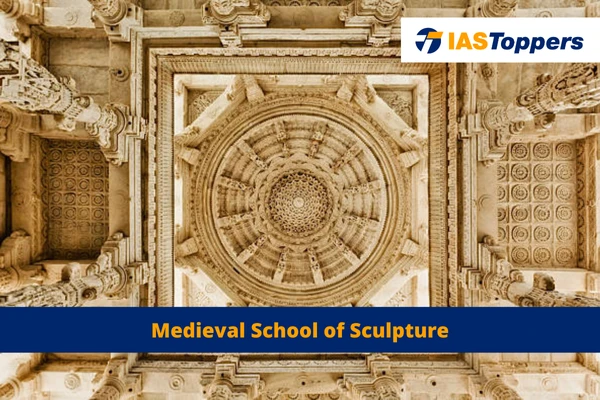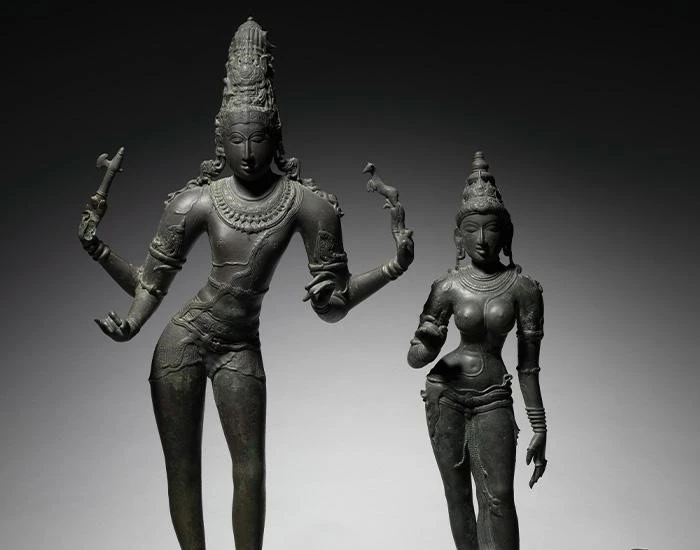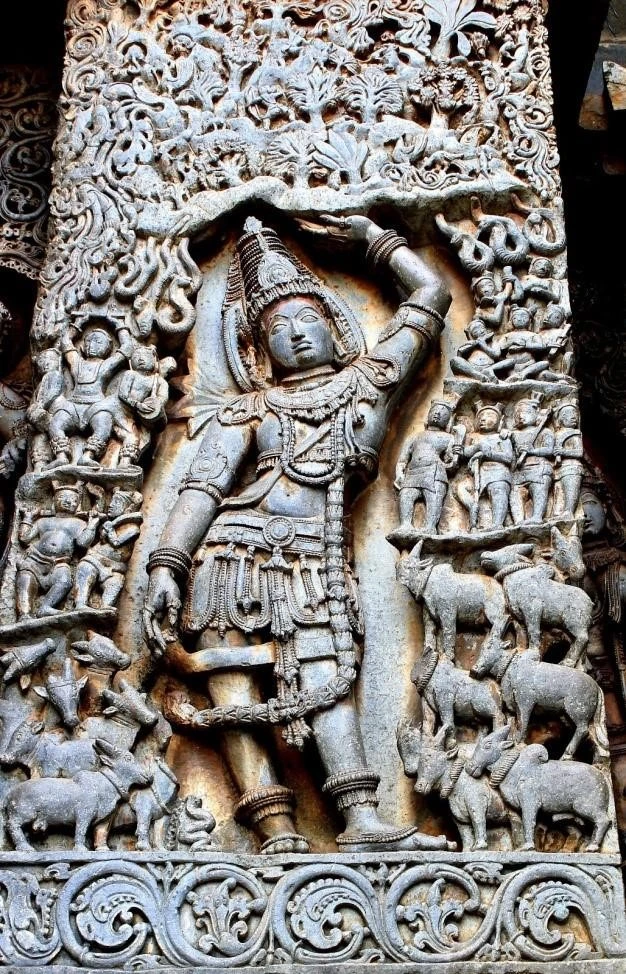The Medieval School of Sculpture in India is mainly based on the religious themes and in different styles. Over the years it has been developed under various dynasties, each having some unique characteristics it contributed to the mesmerizing sculpture throughout the country.
Medieval School of Sculpture will be helpful for UPSC IAS Exam preparation. GS Paper-1 Art and Culture.
Table of Content
- Medieval School of Sculpture
- Pallava Style of Sculpture
- Rashtrakutas Sculpture
- Chola Sculpture
- Chandella Sculpture
- Palas Sculpture
- Eastern Ganga Dynasty
- Marble sculpture of western India
- Hoysala Sculpture
- Vijayanagar Empire Sculpture
- Nayaka sculpture of Madurai and Tanjavur
- Mughal Sculpture
- Conclusion
- Frequently Asked Questions (FAQs)
Medieval School of Sculpture
- The medieval school of sculpture in India is a term used to describe the development of sculptures of the medieval period in India.
- The era is commonly believed to have commenced in the 6th century AD, marked by the ascendancy of the Gupta Empire, and concluded in the 16th century, coinciding with the advent of the Mughal Empire.
- The medieval school of sculpture in India is characterized by its use of a variety of styles, including the Gupta style, the Pallava style, the Chola style, and the Hoysala style.
Here are some of the most important characteristics of medieval sculpture in India:
- Religious themes: Most medieval sculpture in India was religious in nature, and was used to decorate temples and other religious buildings. The most common subjects were scenes from Hindu mythology and the lives of the Buddha and the Jain Tirthankaras. Sculptures were utilized for depicting various religious figures, including Vishnu, Shiva, and the Buddha.
- A variety of styles: Medieval sculpture in India is characterized by its use of a variety of styles.
- Use of specific motifs: Each style of medieval sculpture in India is characterized by its own unique motifs.
- Proportions of the figures: The proportions of the figures in medieval sculpture in India vary depending on the style.
- Treatment of the drapery: The treatment of the drapery in medieval sculpture in India also varies depending on the style.
Some notable instances of medieval sculpture in India include the sculptures found at:
- Ellora Caves,
- Khajuraho temples, and
- Brihadeeswarar Temple in Thanjavur.
Pallava Style of Sculpture
[AT: Mahishasura painting of Mahabalipuram]
- The Pallava style is characterized by tall and slender figures.
- The female figures are much lighter in appearance.
- The figure sculpture is natural in pose and modelling.
- The ornamentations are simple in high relief.
- The sculptures are infused with a certain amount of vigour and fluid grace.
- Examples of Pallava Sculpture:
- Mahishasuramardini in relief
- Girigovardhana panel
- Arjuna’s penance or the Descent of the Ganga
- Trivikrama Vishnu
- Gajalakshmi
- Anatasayanam
Arjuna’s Penance
- One of the most famous examples of Pallava sculpture is Arjuna’s penance scene.
- The scene depicts Arjuna, a Hindu prince, engaged in a fierce battle with a buffalo-headed demon.
- The sculpture is notable for its realistic depiction of the animals and the celestial beings that are also present in the scene.
- The sculpture is also notable for its use of line and its depiction of movement.
Varahamandapa
- Another famous example of Pallava sculpture is the Varahamandapa, a cave temple that is located in Mahabalipuram.
- The cave temple is notable for its intricate carvings, which depict scenes from Hindu mythology.
- The cave temple is also notable for its use of space and its sense of balance.
Rashtrakutas Sculpture
[AT: Sculpture of Shiva and Parvati in Dumar Lena Cave Temple (Ellora)]
- The Rashtrakuta style is characterized by tall and powerfully built figures.
- The figures reflect spiritual and physical poise.
- The sculptures are bold and magnificent.
- The sculptures are characterized by:
- Dignified grace and gentle solemnity,
- Quivering mountain and agitated Parvati,
- King of the Naga and his queen,
- Three heads of Lord Shiva.
Kailasa Temple
- The Kailasa temple is a UNESCO World Heritage Site.
- The temple is carved out of a single rock.
- It is dedicated to Lord Shiva.
- It is located in Ellora, India.
Marriage of Shiva and Parvati
- It is a sculpture located in Cave No.29 at Ellora.
- It depicts the marriage of Lord Shiva and Parvati.
Ravana Shaking Mount Kailasa
- It is a sculpture located in Ellora.
- It depicts Ravana, a demon king, shaking Mount Kailasa, the home of Lord Shiva.
Naga King and Queen
- It is a sculpture located in Ajanta.
- It depicts a Naga king and queen seated on a throne.
- It is notable for its use of detail and its depiction of royalty.
- The sculpture is a masterpiece of Vakataka sculpture.
Mahishamurti
- It is a sculpture located in Elephanta.
- The sculpture depicts Lord Shiva in the form of a three-headed bull.
- The sculpture is notable for its use of symbolism and its depiction of power.
Chola Sculpture
[AT: Chola Bronze Sculpture]
- The Chola style is characterized by graceful contours, flexed poses, delicate ornamentation, pleasing faces, and a certain freshness.
- Chola art influenced the art of Ceylon and travelled as far away as Java and Sumatra.
Brihadesvara Temple
- The Brihadesvara temple is a UNESCO World Heritage Site.
- The temple is located in Thanjavur, India.
- It is dedicated to Lord Shiva.
Gajsurasamaharamurti
- The Gajsurasamaharamurti is a relief carving of Lord Shiva.
- The carving depicts Lord Shiva killing an elephant demon.
- The carving is notable for its use of movement, energy, and emotion.
Bhudevi
- Bhudevi is a sculpture of the earth goddess.
- The sculpture depicts Bhudevi standing on a lotus base.
- It is notable for its use of grace, beauty, and serenity.
Chandella Sculpture
[AT: Sculpture of Celestial Dancer (Devata)]
- The Chandella style is characterized by slender figures with accentuated linear details.
- The sculptures are notable for their grace, beauty, and sensuality.
- The sculptures depict a wide variety of subjects, including gods, goddesses, apsaras, men, and women.
Woman Writing a Love Letter
- This sculpture depicts a woman writing a love letter.
- The woman is slender and graceful.
- She is wearing a simple dress.
- She has long, flowing hair.
- She is holding a pen in her right hand.
- She is looking down at the letter she is writing.
- There are two attendants standing on either side of her.
Celestial Beauty
- This sculpture depicts a celestial beauty.
- The beauty is standing under a stylized mango tree.
- She is holding a mirror in her hand.
- She is applying makeup.
- She is wearing a flowing dress.
- She has long, flowing hair.
Magnificence of Khajuraho
- The sculptures of Khajuraho are a masterpiece of Indian art.
- The sculptures are notable for their grace, beauty, and sensuality.
Palas Sculpture
[AT: Pala Bronze Sculpture]
- The Pala dynasty ruled Bihar and Bengal from the 8th to the 12th centuries.
- They were patrons of the arts and commissioned many temples and sculptures.
- The sculptures of the Pala dynasty are known for their beauty, grace, and technical perfection.
Characteristics of Pala Art
- The Pala style is characterized by slim and graceful figures, elaborate jewellery, and conventional decoration.
- The sculptures from Bihar are somewhat thicker and heavier than those from Bengal.
- The Pala rulers had close ties with Java, which is evident in the Hindu-Javanese sculpture and painting of Nepal, Kashmir, Burma, and Thailand.
Ganga Goddess
- An excellent example of Pala art is the sculpture of the Ganga goddess.
- The goddess is depicted standing gracefully under a tree, holding a water vessel in her hand.
- She is adorned with profuse jewellery andwears a lower garment reaching to her ankles.
- The figure is expressive and the workmanship is of a high order.
Eastern Ganga Dynasty
[AT: King Narasimha worshipping Jagannath (Konark)]
- The Eastern Ganga dynasty ruled Odisha from the 7th to the 13th centuries.
- They were patrons of the arts and commissioned many temples and sculptures.
- The sculptures of the Eastern Ganga dynasty are known for their beauty, grace, and sensuality.
Konark Sun Temple
- The Konark Sun Temple is a UNESCO World Heritage Site.
- It is located in Konark, Odisha, India.
- The temple was built in the 12th century by Narasimhavarman I.
- The temple is dedicated to Surya, the Hindu god of the sun.
- The temple is a masterpiece of Odishan architecture and sculpture.
Sculptures of the Konark Sun Temple
- The sculptures of the Konark Sun Temple depict a variety of subjects, including gods, goddesses, animals, and humans.
Mithunas
- Mithunas is a type of sculpture that depicts a pair of amorous lovers.
- They are a common feature of Odishan art.
- They are a symbol of fertility and love.
- They are a beautiful and sensual expression of human love.
Marble sculpture of Western India
- The marble sculpture of Gujarat is a tradition of intricate carving that can be seen in the Jain temples at Mount Abu, Girnar, and Palitana.
- The sculptures are characterized by their beauty, intricacy, and religious symbolism.
Vishnu Sculpture
- A beautiful example of Gujarati marble sculpture is the image of Vishnu, the Hindu god of preservation.
- The sculpture was created in the 13th century and depicts Vishnu with four arms, each holding a mace, a discus, a conch shell, and a lotus.
- The sculpture is decorated with conventional motifs and miniature images of Brahma and Shiva.
Dilwara Temples
- The Dilwara temples at Mount Abu are outstanding productions of the Western school in the Jain tradition.
- The temples are not monuments of architecture but are sculptural masterpieces, placed one upon the other to fashion one of the sculptural wonders of the world.
- The ceiling of the Dilwara temple is especially noteworthy for its intricate sculptural carvings.
Hoysala Sculpture
[AT: Sculpture of Lord Krishna lifting the Govardhana]
- Hoysala sculptures are characterized by their squat and short stature, elaborate ornamentation, and pleasing appearance.
- Hoysala sculptors took delight in depicting the beauty of the human body, but this trend declined over time.
Lord Krishna Lifting Govardhana Hill
- A splendid example of Hoysala sculptural art is the carving showing Lord Krishna lifting aloft the mountain Govardhana to save the inhabitants of Gokul from the wrath of Indra.
- The sculpture depicts Lord Krishna with his left hand holding the mountain, which is covered in vegetation and animals.
Decline of Human Form
- Over time, Hoysala sculptors began to place more emphasis on ornamentation than on the human form.
- This trend can be seen in sculptures from the period, such as the one depicting a woman holding a fly whisk.
- In these sculptures, the human body is almost completely obscured by ornamentation.
Vijayanagar Empire Sculpture
- The Vijayanagara Empire was the last great Hindu kingdom in South India.
- The empire existed from circa 1336 to 1565 AD.
- The empire was known for its beautiful temples and sculptures.
Temple Architecture
- Vijayanagara temples were built in a variety of styles, including Chola, Chalukya, and Hoysala.
- The temples were decorated with intricate carvings depicting scenes from Hindu mythology.
- The temples were also home to large bronze sculptures of Hindu deities.
Portrait Sculpture
- Vijayanagara emperors commissioned portraits of themselves to be carved into the walls of temples.
- These portraits were often idealized, depicting the emperors as larger-than-life figures.
- The portraits were a way for the emperors to assert their power and authority.
Bronze Sculpture
- Vijayanagara sculptors were skilled in creating life-size bronze sculptures.
- These sculptures were often of Hindu deities, but they also depicted secular subjects such as dancers and musicians.
Nayaka sculpture of Madurai and Tanjavur
[AT: Sculpture of Nayakas at Madurai and Tanjavur]
- The Nayaka dynasty ruled Madurai and Tanjavur from the 16th to the 18th centuries.
- The Nayakas were patrons of the arts and commissioned many temples and sculptures.
- Nayaka art is characterized by its vitality, realism, and use of fantastic detail.
Srirangam Temple
- The Srirangam temple is a Hindu temple located in Tiruchirappalli, India.
- The temple is one of the largest in India and is a UNESCO World Heritage Site.
- The temple is known for its Nayaka-era sculptures, which depict a variety of subjects, including animals, humans, and deities.
Horse Sculptures
- A pair of rampant, furious horses whose heads support the pillars, are carved with great skill and vigor.
- The riders are shown in realistic poses trying to control them.
- Each sculpture is realistic though the concept is fantastic.
Mughal Sculpture
- The Mughal and Muhammadan rulers were patrons of architecture, but not of sculpture.
- As a result, there is a paucity of sculptures from this period.
- The few sculptures that do exist are often the work of local chieftains.
- During the British Raj, there was no patronage for sculpture, and the tradition almost came to a standstill.
Conclusion
The Medieval School of Sculpture in India has unique styles under the many dynasties and empires such as the Pallava Style of Sculpture, Rashtrakutas Sculpture, Chola Sculpture, Chandella Sculpture, Palas Sculpture, Eastern Ganga Dynasty, Marble sculpture of Western India, Hoysala Sculpture, Vijayanagar Empire Sculpture etc. Sculptures at the Ellora Caves, Khajuraho temples, and the Brihadeeswarar Temple are major examples of it.
Ref: Source-1
| Other Articles in History & Culture | |
| Indo-Islamic Architecture | UNESCO World Heritage Sites |
| Pahari School of Painting | Indus Valley Civilization Sculpture |
| Harappan architecture | Pre-Historic Paintings |
FAQs (Frequently Asked Questions)
What is a Relief Sculpture?
Relief Sculpture is a type of sculpture where figures or designs are carved or moulded onto a flat surface, creating a sense of depth and dimensionality.
What are the examples of Medieval School of Sculpture?
Here are some of the most famous examples of medieval sculpture in India: Sculptures at the Ellora Caves, Sculptures at the Khajuraho temples, and Sculptures at the Brihadeeswarar Temple in Thanjavur.
What are the examples of the Pallava Sculpture?
Examples of Pallava Sculpture: Mahishasuramardini in relief, Girigovardhana panel, Arjuna’s penance or the Descent of the Ganga, Trivikrama Vishnu, Gajalakshmi, and Anatasayanam.










